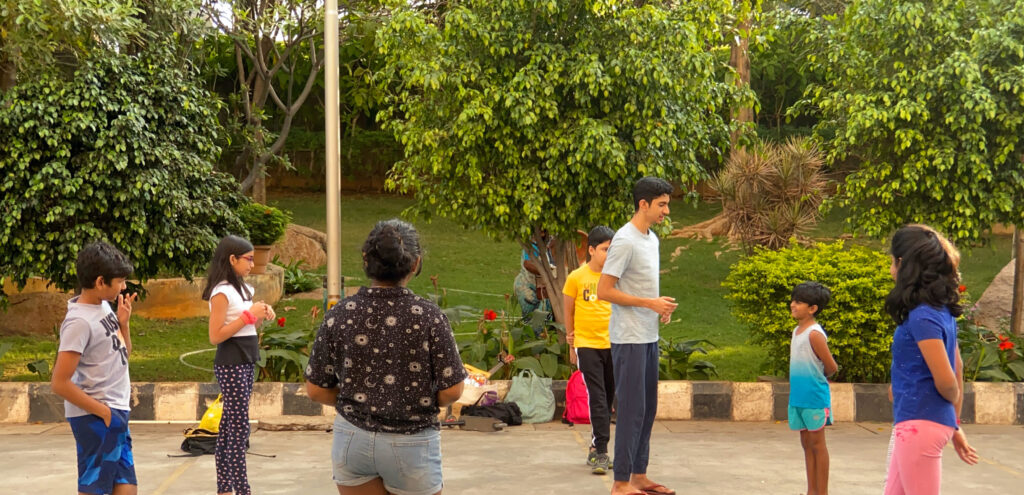
Part 1 – The Role of Facilitators at Imara
This is part one of the five-part series – Why I chose Imara’s Holistic Education for my Child which illustrates one parent’s journey through understanding and embracing Imara’s holistic education (commonly referred as alternative education) system, and its impact on her child as well as the broader society. This part talks about the role of facilitators as ‘change makers’ at Imara, and their impact and relationship with Imara’s students.
Go back to: Introduction
Oh be joyful, Oh be jubilant,
Put your sorrows far away.
Come rejoice and sing together,
This happy day.
I often find myself singing this happy song, although, honestly, it was a bit odd during the first two days of the facilitator training program. Each day, at the beginning of our training session at Imara, we would sing a few songs that students generally sing at the designated ‘circle time’. The beauty of these songs gradually transpired to me, and their exuberant energy stayed with me throughout the ten days of my training.
From songs, we moved to deep discussions on various ways to nurture the physical, mental, and emotional aspects of a child. The goal of these efforts is to draw out and channelize the innate potential within every child. The meaning of this ‘potential’ and the role of education in invoking it is well encapsulated in Sri Aurobindo’s words below.
“Everyone has in him something divine, something his own, a chance of perfection and strength in however small a sphere which God offers him to take or refuse. The task is to find it, develop it & use it. The chief aim of education should be to help the growing soul to draw out that in itself, which is best and make it perfect for a noble use.”
Throughout our training, we discussed how to acknowledge and treat each child as an expression of divine energy, and how to nurture them. Here, I have a confession to make – I have always tried to find ways and means to get involved with Imara – and to learn about the transformative learning that is imparted to its students – something that I personally feel is nothing short of ‘magic’! The reason I call it magic is because the way this learning is delivered is so subtle – practically invisible, and yet the results are so fairly visible in a free-spirited yet conscious behavior, coupled with the love for learning and a desire for deep exploration. My curiosity to witness this firsthand led me to request Imara’s facilitators to make an exception and allow me to be a part of their training sessions.
Surprisingly, even after ten days of in-depth discussions, I still didn’t identify the ‘secret sauces’ that act as the ‘change makers’ for Imara’s students. Today, I realize that it is not the individual processes, but rather a combination of them – of every piece of effort put in by the facilitators, staff, and children – every single day – that nurtures the very core of a child’s being, leading to the unfurling of their inner beauty.
Above all – let me not forget to acknowledge the role that the environment plays. The environment at Imara is free of fear, judgement, and competition – it is an ideal ground for learning to take its course naturally.
As we discussed and discovered each of these subtle components and their role towards the broader purpose, my understanding and respect for an Imara’s system of education – also known as holistic or alternative education – grew deeper and deeper. I am still amazed at how the facilitators at Imara identify every child’s unique needs, and design a customized learning plan around the same.
Each day of the facilitator training was concluded with a form drawing session – a way of expressing art that is repetitive though deeply immersive, leading to a very relaxing and meditative experience for adults. For children, this helps build critical mental faculties and skills in a fun and engaging manner.
Throughout all the conversations and experience in the training, one thing that was crystal clear was how facilitators had to first put a lot of work on themselves to be then able to impart learning to students. There were several exercises that stimulated various parts of our physical, mental, and emotional selves, and we discussed ways to nurture these. Of course, this is a continuous journey for the facilitators – but the fact remains – as long as they are putting an earnest effort and working from a place of love and purpose – students will always respond to that energy and sincerity.
This in no way underplays the importance of a subject matter expertise and knowledge that a facilitator must have. And yet, it should never be the other way around. Simply expertise without the right purpose and approach will never work. It is the right combination of these that gradually implores a child’s mind, senses, and emotions – making learning a natural process for them. This ‘joy of learning’ embodies itself into their very being, making them lifelong learners.
So, what did I learn about the physical, mental, vital and divine elements? I realized their interconnectivity and explored tools that can be used by any adult to facilitate this training for themselves and children. Throughout the training, the only feeling that overwhelmed me was how much this space had to offer! This was the secret sauce behind the all-round development of our children. Naturally, one blog will not do justice to these elements, and I have taken the liberty to illustrate them further in subsequent parts.
Next: Part Two: Why Does the World Need Holistic Education?